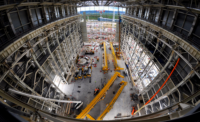One of Europe’s notable museums of art and design this month started detailing structural engineering, focusing on the work of Anglo-Danish Ove Arup (1895-1988), whose name survives through the firm he founded in 1946.
“We may not know it, but engineers organize the world we live in,” says Martin Roth, director of London’s 164-year-old Victoria and Albert Museum (V&A). “Our lives are reliant on visible and invisible systems conceived, built, run or facilitated by the many disciplines of contemporary engineering.”
Citing Arup as “the greatest engineer of the 20th century” the V&A’s curators highlight the engineer’s close collaboration with avant-garde architecture early in the last century.
Ove Arup brought engineering and architecture closer together than ever before through his philosophy of “Total Design.”
Images of the slender, spiraling ramps of the 1934 Penguin Pool in London zoo illustrate the merging of architecture and engineering. An expert in concrete design, Arup collaborated with the architect Berthold Lubetkin to create the now highly prized structure.
A few years later, Arup turned his considerable skills to the war effort. The exhibition charts his unsuccessful attempts to persuade the British government to build large, spacious, concrete underground air raid shelters instead of the make-shift structures that were officially sanctioned.
Arup was more successful later when he helped design the huge precast concrete floating Mulberry Harbour used by allied forces during 1944 Normandy invasion.
What’s more, his reputation for innovative design went global in the 1960s when a team he led devised a way of rescuing the unbuildable sail-like shell roof Sydney Opera House in Australia.
With photographs, diagrams and the original wind tunnel model, the exhibition reveals the complexity of the Sydney project. Pioneering design included the early vacuum-tube Pegasus computer built by Ferranti Ltd. and on display at the exhibition.
Arup built his firm on his principle of integrated design and his successors remained faithful to that philosophy. Exhibits including the skeletal Centre Pompidou gallery in Paris and The Hongkong and Shanghai Banking Corp. Ltd. in Hong Kong reveal greater complexity than the Penguin Pool but the same mingling of disciplines.
Arup is the star of V&A’s engineering show, but his supporting cast also make an appearance. The hand written calculations by Felix Samely that made the penguin ramps possible are on display. Peter Rice, Ted Happold and other collaborators also are there.
Arup’s “vision, combining philosophy and engineering to create a holistic approach” is more relevant today than ever, notes Tristram Carfrae, the design firm’s deputy chairman. Being chosen by the V&A for its first engineering exhibition “demonstrates how Ove was a pioneer of his time,” he adds.
The London's museum exhibition, called Engineering the World: Ove Arup and the Philosophy of Total Design, began on June 18 and will last through November 6.












Post a comment to this article
Report Abusive Comment